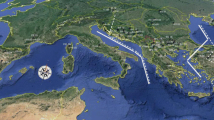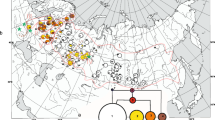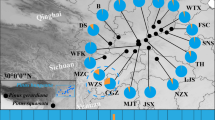Abstract
It has been suggested that the eastern Asian temperate flora have responded to Quaternary climatic changes in a different way compared with temperate plants in Europe and Northern America. However, knowledge about their phylogeographic structure and evolutionary history is still limited. In this study we investigated mitochondrial DNA variation in 17 populations of Pinus kwangtungensis, a five-needled pine inhabiting in isolated mountains of southern China and northern Vietnam. A total of ten mitochondrial haplotypes (mitotypes) were characterized by the polymorphisms of two fragments (cox-1-2 and nad7 intron1), and total genetic diversity was high (h T = 0.847). The construction of phylogenetic relationships of the ten mitotypes detected three major, well-distinct clades, largely corresponding to four population groups identified by SAMOVA analysis. SAMOVA also indicated that most genetic variance should be attributed to among-group differentiation (F CT = 0.868), consistent with the substantial genetic structure found within P. kwangtungensis (G ST = 0.751). The genetic distances of P. kwangtungensis weakly but significantly correlated with geographical distances (R = 0.228, P = 0.03), revealing a pattern of isolation-by-distance. Demographic analysis did not detect any bottleneck events in the recent history of P. kwangtungensis. These results clearly suggested that there were three major refugia for this montane temperate conifer during warm stages (along with other minor refugia), and that the species would have tracked Quaternary climatic changes by expanding to nearby lowlands in the glacial periods, and by retreating to mountaintops (the refugia) during interglacial warmer stages, experiencing fragmentation and isolation among refugia.



Similar content being viewed by others
References
Abbott RJ, Brochmann C (2003) History and evolution of the Arctic flora: in the footsteps of Eric Hult. Mol Ecol 12:299–313
Abbott RJ, Smith LC, Milne RI, Crawford RMM, Wolff K, Balfour J (2000) Molecular analysis of plant migration and refugia in the Arctic. Science 289:1343–1346
Aizawa M, Yoshimaru H, Saito H (2007) Phylogeography of a northeast Asian spruce, Picea jezoensis, inferred from genetic variation observed in organelle DNA markers. Mol Ecol 16:3393–3405
Axelrod DI, Al-Shehbaz I, Raven PH (1996) History of the modern flora of China. Floristic characteristics and diversity of east Asian plants. China Higher Education Press, Beijing, pp 43–55
Bennett KD, Provan J (2008) What do we mean by ‘refugia’? Quat Sci Rev 27:2449–2455
Bouillé M, Bousquet J (2005) Trans-species shared polymorphisms at orthologous nuclear gene loci among distant species in the conifer Picea (Pinaceae): implications for the long-term maintenance of genetic diversity in trees. Am J Bot 92:63–73
Burban C, Petit RJ (2003) Phylogeography of maritime pine inferred with organelle markers having contrasted inheritance. Mol Ecol 12:1487–1495
Chen KM, Abbott RJ, Milne RI, Tian XM, Liu JQ (2008) Phylogeography of Pinus tabulaeformis Carr. (Pinaceae), a dominant species of coniferous forest in northern China. Mol Ecol 17:4276–4288
Chiang YC, Hung KH, Schaal BA, Ge XJ, Hsu TW, Chiang TY (2006) Contrasting phylogeographical patterns between mainland and island taxa of the Pinus luchuensis complex. Mol Ecol 15:765–779
Clement M, Posada D, Crandall KA (2000) TCS: a computer program to estimate gene genealogies. Mol Ecol 9:1657–1659
Cornuet JM, Luikart G (1996) Description and power analysis of two tests for detecting recent population bottlenecks from allele frequency data. Genetics 144:2001–2014
Day DA, Millar AH, Whelan J (2004) Plant mitochondria: from genome to function. Kluwer, Dordrecht, pp 121–142
Dechaine EG, Martin AP (2004) Historic cycles of fragmentation and expansion in Parnassius smintheus (Papilionidae) inferred using mitochondrial DNA. Evolution 58:113–127
Dechaine EG, Martin AP (2005) Marked genetic divergence among sky island populations of Sedum lanceolatum (Crassulaceae) in the rocky mountains. Am J Bot 92:477–486
Doyle JJ, Doyle JL (1987) A rapid DNA isolation procedure for small quantities of fresh leaf tissue. Phytochem Bull 19:11–15
Dupanloup I, Schneider S, Excoffier L (2002) A simulated annealing approach to define the genetic structure of populations. Mol Ecol 11:2571–2581
Dvornyk V, Sirvio A, Mikkonen M, Savolainen O (2002) Low nucleotide diversity at the pal1 locus in the widely distributed Pinus sylvestris. Mol Biol Evol 19(2):179–188
Echt CS, Deverno LL, Anzidei M, Vendramin GG (1998) Chloroplast microsatellites reveal population genetic diversity in red pine, Pinus resinosa Ait. Mol Ecol 7:307–316
Eckert AJ, Hall BD (2006) Phylogeny, historical biogeography, and patterns of diversification for Pinus (Pinaceae), phylogenetic tests of fossil-based hypotheses. Mol Phylogenet Evol 40:166–182
Ferguson DK (1993) The impact of late Cenozoic environmental changes in East Asia on the distribution of terrestrial plants and animals. In: Jablonski NG (ed) Evolving landscapes and evolving biotas of East Asia since the Mid-Tertiary. Proceedings of the 3rd conference on the evolution of east Asian environment, Centre of Asian Studies, University of Hong Kong, Hong Kong, pp 145–196
Gong W, Chen C, Dobes C, Fu CX, Koch MA (2008) Phylogeography of a living fossil, Pleistocene glaciations forced Ginkgo biloba L. (Ginkgoaceae) into two refuge areas in China with limited subsequent postglacial expansion. Mol Phylogenet Evol 48(3):1094–1105
Gonzales E, Hamrick JL, Chang SM (2008) Identification of glacial refugia in south-eastern North America by phylogeographical analyses of a forest understorey plant, Trillium cuneatum. J Biogeogr 35:844–852
Haffer J (1969) Speciation in Amazonian forest birds. Science 165:131–137
Hewitt GM (1996) Some genetic consequences of ice ages, and their role in divergence and speciation. Biol J Linn Soc 58:247–276
Hewitt GM (1999) Post-glacial re-colonization of European biota. Biol J Linn Soc 68:87–112
Hewitt GM (2000) The genetic legacy of the quaternary ice ages. Nature 405:907–913
Hewitt GM (2004) Genetic consequences of climatic oscillations in the Quaternary. Philos Trans R Soc Lond 359:183–195
Hu FS, Hampe A, Petit RJ (2009) Paleoecology meets genetics: deciphering past vegetational dynamics. Front Ecol Environ 7:371–379
Jaramillo-Correa JP, Beaulieu J, Bedig FT, Bousquet J (2006) Decoupled mitochondrial and chloroplast DNA population structure reveals Holocene collapse and population isolation in a threatened Mexican-endemic conifer. Mol Ecol 15:2787–2800
Jaramillo-Correa JP, Aguirre-Planter E, Khasa DP, Eguiarte LE, Piñero D, Furnier GR, Bousquet J (2008) Ancestry and divergence of subtropical montane forest isolates: molecular biogeography of the genus Abies in southern Mexico and Guatemala. Mol Ecol 17:2476–2490
Johansen AD, Latta RG (2003) Mitochondrial haplotype distribution, seed dispersal and patterns of postglacial expansion of ponderosa pine. Mol Ecol 12:293–298
Ledig FT, Bermejo-Velázqez B, Hodgskiss PD, Johnson DR, Flores-López C, Jacob-Cervantes V (2000) The mating system and genic diversity in Martinez spruce, an extremely rare endemic of Mexico’s Sierra Madre Oriental, an example of facultative selfing and survival in interglacial refugia. Can J For Res 30:1156–1164
Liepelt S, Bialozyt R, Ziegenhagen B (2002) Wind-dispersed pollen mediates postglacial gene flow among refugia. Proc Natl Acad Sci USA 99:14590–14594
Liew PM, Kuo CM, Huang SY, Tseng MH (1998) Vegetation change and terrestrial carbon storage in eastern Asia during the last glacial maximum as indicated by a new pollen record from central Taiwan. Glob Planet Change 16–17:85–94
Liu H, Xing Q, Ji Z, Xu L, Tian Y (2003) An outline of quaternary development of Fagus forest in China: palynological and ecological perspectives. Flora 198:249–259
Luikart G, Allendorf FW, Cornuet JM, Sherwin WB (1998) Distortion of allele frequency distributions provides a test for recent population bottlenecks. J Hered 89:238–247
Naydenov K, Senneville S, Beaulieu J, Tremblay F, Bousquet J (2007) Glacial vicariance in Eurasia: mitochondrial DNA evidence from Scots pine for a complex heritage involving genetically distinct refugia at mid-northern latitudes and in Asia Minor. BMC Evol Biol 7:233
Petit RJ, Pineau E, Demesure B, Bacilieri R, Ducousso A, Kremer A (1997) Chloroplast DNA footprints of postglacial recolonization by oaks. Proc Natl Acad Sci USA 94:9996–10001
Petit RJ, Aguinagalde I, De Beaulieu JL, Bittkau C, Brewer S, Cheddadi R, Ennos R, Fineschi S, Grivet D, Lascoux M, Mohanty A, Müller-Starck G, Demesure-Musch B, Palmé A, Martin JP, Rendell S, Vendramin GG (2003) Glacial refugia, hotspots but not melting pots of genetic diversity. Science 300:1563–1565
Petit RJ, Duminil J, Fineschi S, Hampe A, Salvini D, Vendramin G (2005) Comparative organization of chloroplast, mitochondrial and nuclear diversity in plant populations. Mol Ecol 14:689–701
Petit RJ, Hu FS, Dick CW (2008) Forest of the past: a window to future changes. Science 320:1450–1452
Piry S, Luikart G, Cornuet JM (1999) BOTTLENECK: a program for detecting recent effective population size reductions from allele data frequencies. J Hered 90:502–503
Pons O, Petit RJ (1996) Measuring and testing genetic differentiation with ordered versus unordered alleles. Genetics 144:1237–1245
Posada D, Crandall KA, Templeton AR (2000) GeoDis: a program for the cladistic nested analysis of the geographical distribution of genetic haplotypes. Mol Ecol 9:487–488
Price RA, Liston A, Strauss SH (1998) Phylogeny and systematics of Pinus. In: Richardson DM (ed) Ecology and Biogeography of Pinus. Cambridge University Press, Cambridge, pp 49–68
Qian H, Ricklefs RE (1999) A comparison of the taxonomic richness of vascular plants in China and the United States. Am Nat 154(2):160–181
Qian H, Ricklefs RE (2000) Large-scale processes and the Asian bias in species diversity of temperate plants. Nature 407:180–182
Raymo ME (1994) The initiation of northern hemisphere glaciation. Annu Rev Planet Sci 22:353–383
Richardson DM, Rundel PW (1998) Ecology and biogeography of Pinus: an introduction. In: Richardson DM (ed) Ecology and Biogeography of Pinus. Cambridge University Press, Cambridge, pp 3–40
Ronikier M, Costa A, Aguilar JF, Feliner GN, Küpfer P, Mirek Z (2008) Phylogeography of Pulsatilla vernalis (L.) Mill. (Ranunculaceae): chloroplast DNA reveals two evolutionary lineages across central Europe and Scandinavia. J Biogeogr 35:1650–1664
Rousset F (1997) Genetic differentiation and estimation of gene flow from F-statistics under isolation by distance. Genetics 145:1219–1228
Schaal BA, Hayworth DA, Olsen KM, Rauscher JT, Smith WA (1998) Phylogeographic studies in plants, problems and prospects. Mol Ecol 7:465–474
Schneider S, Roessli D, Excoffier L (2000) Arlequin ver 2.000: a software for population genetics data analysis. University of Geneva, Geneva
Soltis DE, Morris AB, McLachlan JS, Manos PS, Soltis PS (2006) Comparative phylogeography of unglaciated eastern North America. Mol Ecol 15(14):4261–4293
Syring J, Farrell K, Businský R, Cronn R, Liston A (2007) Widespread genealogical nonmonophyly in species of Pinus subgenus Strobus. Syst Biol 66:163–181
Tian S, Luo LC, Ge S, Zhang ZY (2008) Clear genetic structure of Pinus kwangtungensis (Pinaceae) revealed by a plastid DNA fragment with a novel minisatellite. Ann Bot 102(1):69–78
Wang HW, Ge S (2006) Phylogeography of the endangered Cathaya argyrophylla (Pinaceae) inferred from sequence variation of mitochondrial and nuclear DNA. Mol Ecol 15:4109–4122
Weir BS (1996) Genetic data analysis II: methods for discrete population genetic data. Sinauer Inc, Sunderland
Wolfe KH, Li WH, Sharp PM (1987) Rates of nucleotide substitution vary greatly among plant mitochondrial, chloroplast, and nuclear DNAs. Proc Natl Acad Sci USA 84:9054–9058
Xiang QP (2001) A preliminary survey on the distribution of rare and endangered plants of Abies in China. Guihaia 21(2):113–117
Yu G, Prentice IC, Harrison SP, Sun XJ (1998) Pollen-based biome reconstructions for China at 0 and 6000 years. J Biogeogr 25:1055–1069
Yuan SL, Lin LK, Oshida T (2006) Phylogeography of the mole-shrew (Anourosorex yamashinai) in Taiwan, implications of interglacial refugia in a high-elevation small mammal. Mol Ecol 15:2119–2130
Zhang ZR, Luo LC, Wu D, Zhang ZY (2009) Two genetically distinct units of Sinomanglietia glauca (Magnoliaceae) detected by chloroplast PCR-SSCP. J Syst Evol 47:110–114
Zheng Z (2000) Vegetation and climate since the late Pleistocene in southern China. J Geosci China 2:7–20
Acknowledgments
We are indebted to Qing-Jun Yuan and Lin-Bin Zhang for help in molecular techniques. Many thanks go to Dr Philip Thomas of Royal Botanic Garden of Edinburgh for his insightful comments. This work is supported by the National Science Foundation of China (NSFC 30460020) and the Cultivation Programs for Young Scientists of Jiangxi Province (2008DQ01500).
Author information
Authors and Affiliations
Corresponding author
Electronic supplementary material
Below is the link to the electronic supplementary material.
Rights and permissions
About this article
Cite this article
Tian, S., López-Pujol, J., Wang, HW. et al. Molecular evidence for glacial expansion and interglacial retreat during Quaternary climatic changes in a montane temperate pine (Pinus kwangtungensis Chun ex Tsiang) in southern China. Plant Syst Evol 284, 219–229 (2010). https://doi.org/10.1007/s00606-009-0246-9
Received:
Accepted:
Published:
Issue Date:
DOI: https://doi.org/10.1007/s00606-009-0246-9




